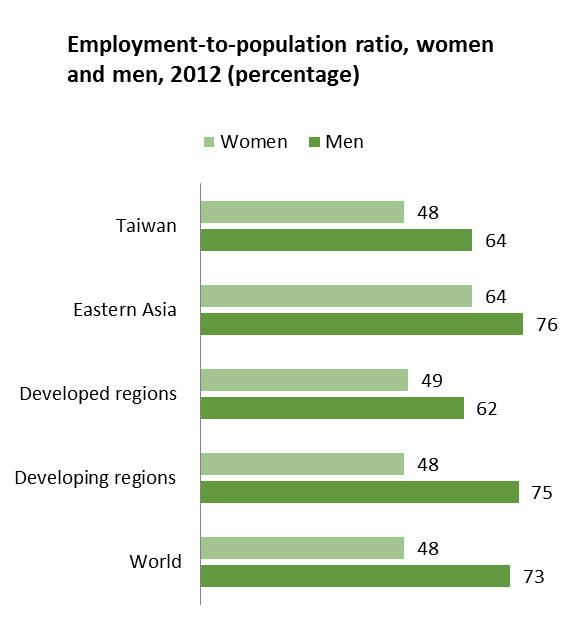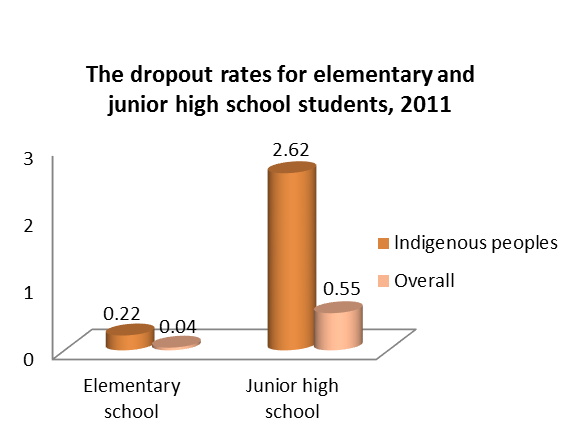At the Millennium Summit in 2000, the 189 member states of the United Nations adopted the UN Millennium Declaration. Next year, the UN Secretary-General publish eight Millennium Development Goals (MDGs) for sustainable global development in the new century, with a target date of 2015 for achieving the time-bound targets of those goals. In accordance with this deadline, the fifty-eighth session of the Commission on the Status of Women in 2014 will examine the implementation of the development goals for women and girls in all member countries as well as deliberate on how to integrate gender perspectives into the framework of international development beyond 2015.
Under the collaboration of public and private sectors, women's rights and gender equality in the R. O. C (Taiwan) has made rapid progress in various fields after the lifting of martial law in 1987. We summarize our major achievements since the year 2000 from the dimensions of economic security, education and empowerment, health promotion, environmental sustainability, compare Taiwan's t performances of gender-related indicators with other countries, and also identify the challenges that Taiwan has encountered. Upon the achievement and challenges, we hope to envision of the future of women's rights and gender equality.
|
MDG 4: Reduce Child Mortality |
|
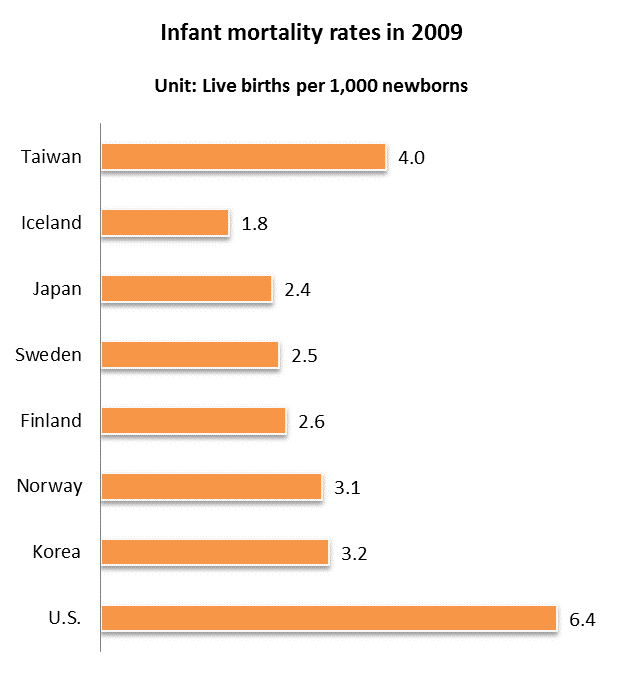 Source: Ministry of Health and Welfare, R. O. C. |
Target 4.A: Reduce by two thirds, between 1990 and 2015, the under-five mortality rate Where we are: In 2010, the mortality rate for children under five in the R.O.C. (Taiwan) was 5.5%. The government has conducted various statistical analyses on infant mortality rates by gender and population. From the results, the mortality rate for male and female infants were 4.6% and 3.8%, respectively, showing no significant difference. However, the indigenous infant mortality rate was as high as 9.6%, indicating relatively insufficient medical resources received by the indigenous people. For the causes of death, specific conditions originating from the prenatal period are at the top of the leading causes of death among children under five,while second place is congenital malformations and chromosomal anomalies, and the third is accidental injuries. Prenatal diagnosis reduces the number of deaths among infants and child with congenital malformations: The R.O.C. (Taiwan) provides ten free prenatal care visits and one ultrasound examination to pregnant women and also offers financial support for high-risk pregnant women (e.g. advanced age, family history of genetic disorders, risk probability greater than 1/270 after serum screening, and fetal abnormalities identified by ultrasound, etc.) to have chromosomal and genetic testing in order to ensure early diagnosis of abnormalities and provide counseling services. This helps prevent adverse birth outcomes as well as reduce the number of live births with high risks. Between 2000 and 2011, the number of deaths for infants and child with congenital and chromosomal abnormalities had been reduced by 64%. Mother-baby friendly environment promotes maternal as well as child health: In 2001, the R.O.C. (Taiwan) initiated the certification program to promote mother-baby friendly hospitals and started to offer training courses of breastfeeding counseling for health care professionals as well as to set up consultation websites, hotlines and human milk banks. Moreover, the Act Governing Breastfeeding in Public Places was implemented at the end of 2010 so as to protect mothers' right to breastfeed in public places. Between 2001 and 2013, mother-baby friendly hospitals have increased from 38 to 176, covering 78.6% of the births nationwide. |
|
MDG5: Improve Maternal Health |
|
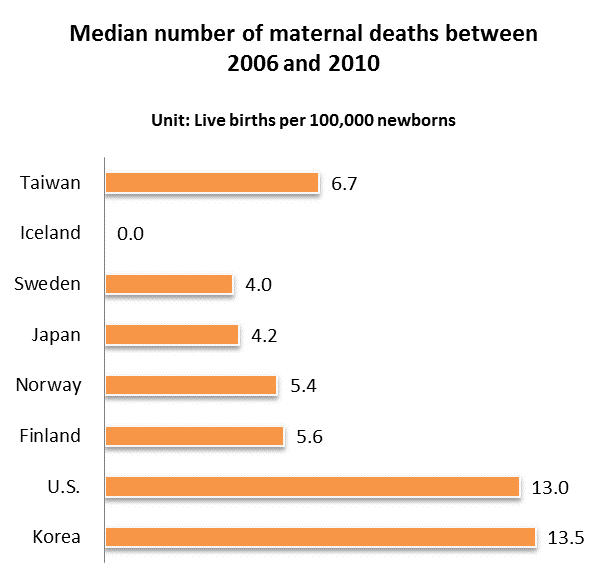 Source: Ministry of Health and Welfare, R. O. C |
Target 5.A: The maternal mortality rate, between 1990 and 2015, reduce by three fourths Where we are: In the R.O.C. (Taiwan), the maternal mortality rate has decreased to less than 10 deaths per 100,000 live births since 1986, yet the number has remained almost the same since then. The lowest rate of 4.2 deaths per 100,000 live births was observed in 2010 and the highest rate was reported in 2012 with 8.5 deaths per 100,000 live births, which are still relatively higher than other medically advanced countries. Furthermore, the percentage of advanced-maternal-aged women has increased, and with problems such as obesity, pregnancy-associated complications including high blood pressure, diabetes and pregnancy toxemia are all challenges for reducing the maternal mortality rate. Target 5.B: Achieve universal access to reproductive health by 2015 Where we are: Under the coverage of National Health Insurance, in the R.O.C. (Taiwan), 99.9% of the babies are delivered by doctors, and mothers can receive safe birth care from the professionals; however, the needs of pregnant women with physical or mental disabilities remain commonly ignored. In addition, the OB/GYN personnel shortage in recent years and disproportional distribution of resources between urban and rural areas have gradually lowered the number of regular prenatal exams, particularly in the eastern regions, where more indigenous people live, the pregnant women who are able to receive at least one or four regular checkups are far fewer compared to other areas. And the situation has shown a worsening trend over the years. Maternal Health Handbook and interpretation services promotes the reproductive health of female immigrants: To promote reproductive health, the R.O.C. (Taiwan) regularly publishes and revises the "Maternal Health Handbook" and has translated it into five different languages including Vietnamese, Cambodian, Thai, Indonesian and English, and has made a series of short films on the topic of reproductive health to help new immigrants obtain relevant information on topics such as pregnancy, childbirth and newborn care, etc. Meanwhile, training programs are offered to new residents who have lived in Taiwan for many years so that they can act as interpreters to provide medical assistance and help reducing inequalities in reproductive health caused by language barriers or insufficient resources. |
|
MDG6: Combat HIV/AIDS |
|
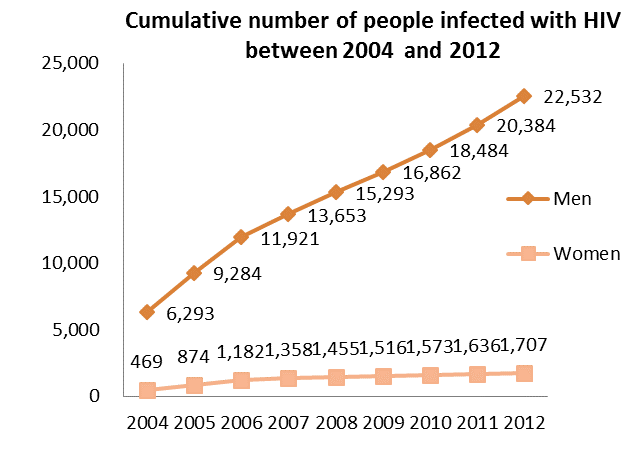 Source: Ministry of Health and Welfare, R. O. C. |
MDG6: Combat HIV/AIDS Target 6.A: Have halted by 2015 and begun to reverse the spread of HIV/AIDS Target 6.B: Achieve, by 2010, universal access to treatment for HIV/AIDS for all those who need it Where we are: In the end of 2012, the total number of people infected with HIV in the R.O.C. (Taiwan) was 24,239. Aged 20-29 accounted for the largest percentage, 40.4%, of all the infected population with a total number of 9,741 . From a gender perspective, 1,707 women were infected, which accounts for 7.0% of the total infected population. Compare to other region in Asia or worldwide, the infection rate of women was significantly lower in Taiwan and has gradually decreased over the years. Two most common approaches of contracting HIV among women in Taiwan are heterosexual sex and drug abuse. Those infected through drug abuse increased dramatically between 2004 and 2007, then gradually decreased since the implementation of Harm Reduction Program for Drug Addiction. In 2012, 71.2% of the infected women were infected through heterosexual sex, indicating that women's health is still affected by unprotected sex as well as unequal gender relations. Harm Reduction Program inhibits drug addiction-related HIV infection: The R.O.C. (Taiwan) initiated the Harm Reduction Program for drug addiction-related AIDS in 2005 by providing free clean needles, methadone substitution treatment, health education, counseling and other measures to effectively stop the spread of AIDS. Between 2005 and 2012, the numbers of women and men infected with HIV due to drug abuse have dropped from 328 to 14 and 2,092 to 67 people, respectively. |
| 7. Former Site of Awakening Foundation in Boai Road in Taipei | |
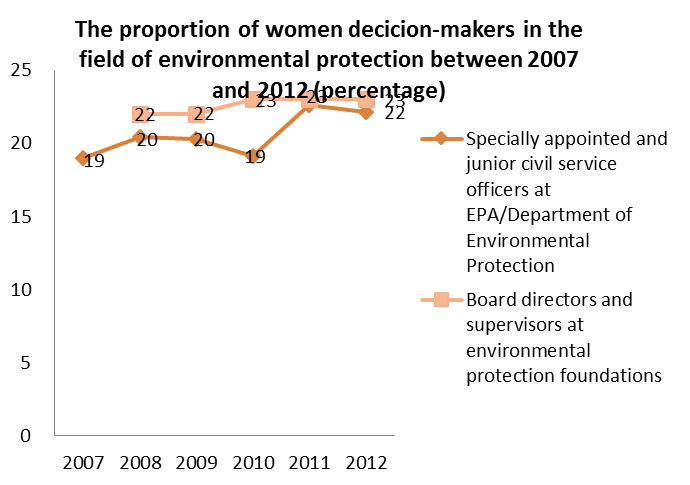 Source: Environment Protection Administration, Executive Yuan, R. O. C |
Target 7.A: Integrate the principles of sustainable development into country policies and programs and reverse the loss of environmental resources Where we are: The impact on the ecosystem and negative effects on local residents from climate change, natural disasters and human development has become important issues over the years. However, in national environmental policies, the uniqueness of women's situations and the necessity of women's participation in the decision-making remains largely ignored. Environmental Protection Administration is the highest decision-making agency for environmental policies in Taiwan, and since its inception in 1987, all 12 former ministers have been men. Additionally, among all 14 general directors of the Department of Environmental Protection of Taipei City Government, only one was female g . Since 2007, the gender statistics of environmental protection personnel shows that the percentage of specially appointed and junior civil service officers that were women was merely between 19% and 23% among various government departments. Likewise, the percentage of women board members amongst private environmental protection foundations was between 22% and 23%. The gender issue as well as the needs of disadvantaged groups should be included in the vision "Sustainable Environment" of the Golden Decade: The "Golden Decade National Vision" program was launched in 2013, the fifth vision within the project is a "sustainable environment" that includes three main themes: green energy and carbon reduction, ecological community and disaster prevention. Among the 3 themes above, disaster prevention project aims to benefit mainly indigenous people and elderly women. Important topics that require attention include: how to integrate the gender issue and assess the eco-safety coefficients in general, providing appropriate disaster prevention strategies as well as protocols, and enhancing the self-help abilities of disadvantaged groups when facing a disaster. |
|
MDG8: Develop a global partnership for development |
|
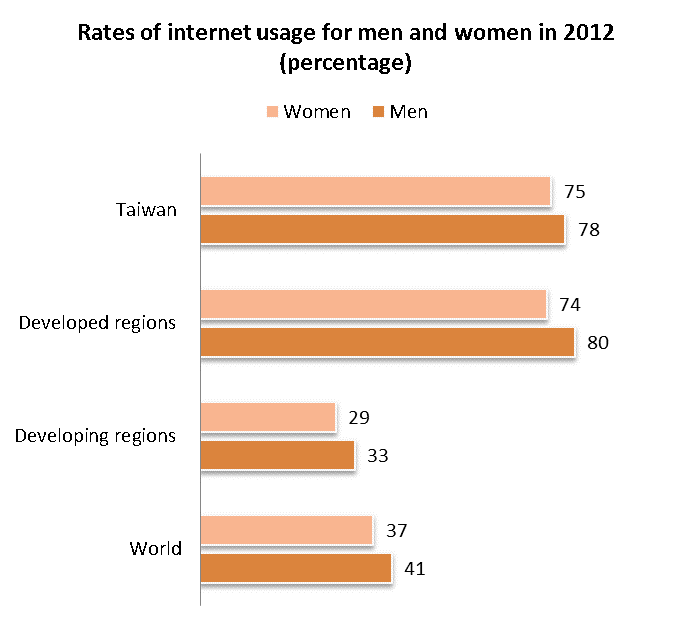 Source: ITU World Telecommunication /ICT, Research, Development and Evaluation Commission, Executive Yuan, R.O.C. |
Target 8.A: Develop further an open, rule-based, predictable, non-discriminatory trading and financial system
Where we are: The R.O.C. (Taiwan) is not a member of the UN, but still participates in training for international personnel, technology cooperation and investment financing, etc., based on the spirit of global togetherness. Moreover, Taiwan directly works with the people or local institutes in partner countries through non-governmental organizations to assess, implement and supervise a number of developmental projects let the achievements of the projects directly benefit the people affected, making substantial contributions to the eight MDGs. Nevertheless, the ODA has not yet analyzed the statistics of the relevant budgets on the empowerment of women and gender equality.
Target 8.F: In cooperation with the private sector, make available benefits of new technologies, especially information and communications
Where we are: Between 2004 and 2012, in the R.O.C. (Taiwan), internet usage rates for women increased from 59% to 69.5%, which is still lower than the men's usage rate of 76.5% in 2012. This is mainly due to women above the age of 40 having lower internet usage rates; the rate for women between the age of 50 to 59 is 13.7% lower than that of men in the same age group. Likewise, when compared with men who are between the age of 40 to 49 and who are above 60, women's internet usage rates are also 9.8% and 8.0% lower, respectively.
Vocational training project assists Swaziland women to start their own businesses: The R.O.C. (Taiwan) launched a vocational training project in Swaziland in 2011. The training provided is tailored toward the needs of local Swaziland women, and by working with the national arts and crafts training centers in Swaziland, various training courses including sewing, mechanics, electricity and plumbing, and computer courses are offered so as to help women obtain professional certificates. Additionally, by establishing information testing centers, training centers and digital opportunity centers, it is now possible to provide computer classes as well as information and communication workshops, so that the digital divide can be narrowed, and the goals of improving women's employment opportunities and entrepreneurship will be achieved.
|
Foundation for Women’s Rights Promotion and Development
In 1999, the Foundation for Women’s Rights Promotion and Development was established under the “Executive Yuan National Women Personal Safety Found” to serve as a bridge between the government and the civil society, and to build a resource center for women in Taiwan.
The foundation is comprised of chiefs from ministries engaged in women’s issues, advocates from women’s groups, professionals and scholars. We are dedicated to promoting women’s rights and has conducted gender equality on the following issues:
- Promote gender mainstreaming and gender resources kits
- Enhance women empowerment and education
- Develop women/gender network through various platform
- Engage in International exchange and participation
In the future, we will continue to promote women’s rights and establish a society of gender equality and mutual respect.

